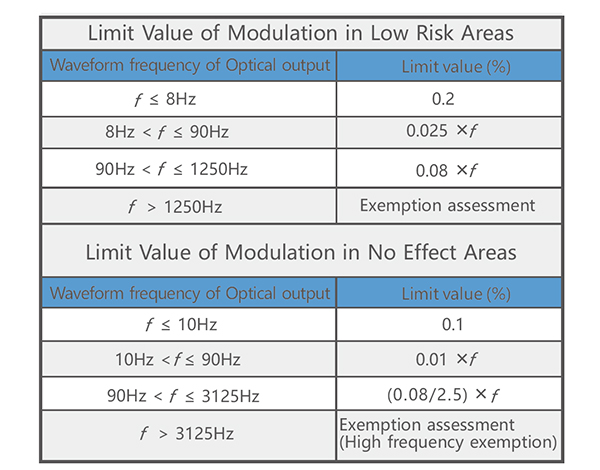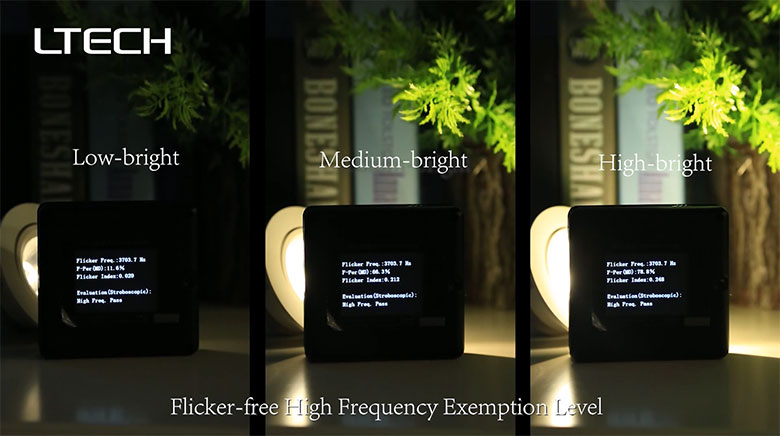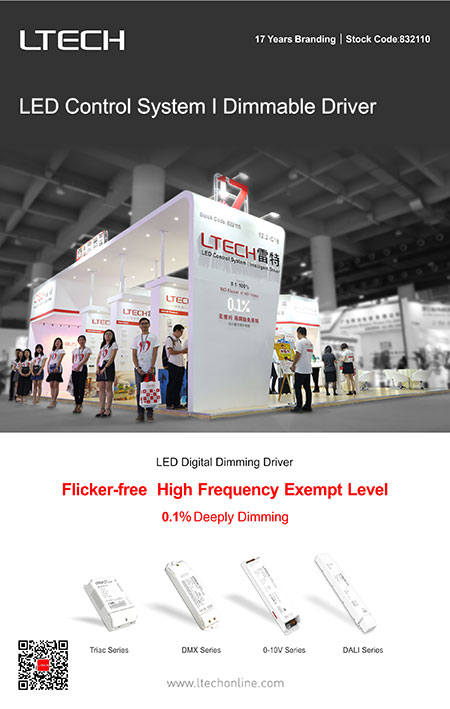
Since the awareness of green light become much stronger, Many people still have much misconceptions about LED stroboscopic .
1.Lighting flicker is not entirely negative in life
In addition to being annoying, the flicker of lighting can cause serious illnesses such as headaches, visual impairment,or epileptic seizures in extreme cases,.Even if the flicker is mild, such as at a high frequency of 100 to 150 Hertz, your eyes may not be consciously looking at it, but the brain is still able to detect and react to it, potentially with negative consequences.In particular, athletes of stadium and warehouse workers are more prone to accidents under poor lighting conditions, which can lead to stroboscopic effect.
But in reality, there are still cases of scintillation, these are the "flickers" we want.
◎The lights on ambulances, fire engines and police cars
◎The wing light on which the plane lands
◎The laser light of the concert and the bar
In addition, there are also foreign scientific studies that control the flashing of lights to treat Alzheimer disease.
2.The traditional light source is also stroboscopic, and the LED stroboscopic depends on the LED driver
Almost all types of lights flicker easily, including incandescent lamps, halogen lamps, and even LED bulbs.But each light has a different effect.In incandescent and halogen lamps, for example, filament temperatures react slowly to changes in current, so you won't notice the flickering effect.Leds respond almost immediately to the current change, so flicker will be even more noticeable.
The stroboscopic index is commonly used to describe the stroboscopic degree of the light source.Where, the strobe percentage is equal to the difference between the maximum light output and the minimum light output within a switching cycle divided by the sum of the maximum light output and the minimum light output, and the stroboscopic index is equal to the amount over the average light output within a switching cycle divided by the total light output.The lower the scintillation percentage (wave depth) and the lower the stroboscopic index, the less the scintillation of the light source or the stroboscopic effect.
due to the differences in the use of inductive ballast and electronic ballast, the stroboscopic percentages of double U compact fluorescent lamps are also significantly different, indicating that lighting appliances have a great influence on the stroboscopic.In the same situation, LED will produce severe stroboscopic, which is also because bad LED driver is selected, which has nothing to do with the LED light itself.
3.In terms of stroboscopic, there are different definitions and different reference indexes
There are different definitions and different reference indicators for strobe, such as IEEE, energy star, IEC, CIE...Wait, here are the definitions of two organizations:
(1)Commission Internationale de L'Eclairage

CIE 17.443 e-ilv: the Light effect of time (Temporal Light Artefacts, TLA) : in specific environments, the Light or spectrum of Light that fluctuates with time changes the observer's visual perception.The following flicker, stroboscopic and phantom effects are all different types of TLA.
Definition in CIE tn006-2016:
◎ Flicker: perception of visual instability in a static observer in a static environment, caused by light stimuli whose brightness or spectral distribution fluctuates over time.Unlike the "flicker" or "change in brightness over time" that we've talked about in the past, the environment and the observer are static.
◎ Scope effect: changes in the perception of motion caused by light stimuli whose brightness or spectrum fluctuates with time for static observers in non-static environments (moving objects).For example, under the brightness of the periodic fluctuation of square wave, the continuous moving target will be perceived as discontinuous moving.If the brightness fluctuation period is consistent with the rotation period of the target, the target will be regarded as static.
◎ The phantom array effect: also known as ghost, a change in The perception of The shape or space position of an object caused by light stimuli whose brightness or spectrum fluctuates over time for a non-static observer in a static environment.For example, when scanning a small light source that fluctuates periodically on a square wave, the light source is seen as a series of points of light stretching across space.
(2)(Institute of Electrical and Electronics Engineers)

Definitions in IEEE Std from 1789 to 2015:
◎(time modulation of light)
◎All of the above effects are included
◎Include visual effects and non-visual effects
4.the manufacturer claims that no flicker is really no flicker ?

A shopping platform search results about no flicker lighting fixtures
Does the manufacturer claim that no flicker is really no strobe?It is important to note that if no test criteria or results are specified, the flicker they mentioned may simply mean that you can not see its flicker with the naked eye, unlike what you think.At present, our country has issued the related standard about the flicker to the table lamp, according to the CQC1601-2016 <
In the document released by the IEEE in 2015, flicker risk is divided into several levels. As shown in figure 2, the green area covers the level of no harm, while the yellow area is of low risk.Table 1 and table 2 list the low risk and non-hazardous areas, and the limit value of the lamp strobe percentage (fluctuating depth).

Figure 2 IEEE Std standard 1789-2015
Under the frequency of 50Hz Ac, the strobe frequency of domestic general lamps is 100Hz, and the strobe percentage of measured lamps is less than 3.2%,Is the limit range of no stroboscopic hazards.Of course, as long as the strobe percentage is in the low risk range of 8%, the luminaire strobe is in the safe range. If it is higher than 8%, the lighting product can be regarded as unsafe.

We can clearly see in the previous chart that the frequency f of the optical output waveform is a very important reference indicator. According to the calculation formula, whether if it is less than the corresponding wave depth limit, if it is over, it will not meet its standards.In fact, "no flicker" is not really no strobe at all, but under a certain high frequency (as shown in table 2, the frequency of light output waveform f > 3125 Hz, high frequency exempt level ), it has exceeded the human eye nerve reaction speed (no harm to affect the fluctuation depth limit of horizontal area), and will not damage the eyeball.
There are also some domestic testing institutions related to the quality supervision and testing center of the image electrical light source, which can be tested according to the IEEE Std 1789-2015 standard (see fig.3 test report).Dimming is just another cause of strobe.When the lamp load dimming function, the stroboscopic will often further aggravate.Especially when the dimmer, the wave depth is larger.Therefore, for lighting products that have the dimming function or are claimed to be connected to the dimming controller, their stroboscopic performance should be measured at least when the dimming is at its brightest (100% brightness) and dimmer (20% or less brightness) stroboscopic behavior is measured when dimming.

FIG. 3 test report of relevant testing institutions
According to the test results in fig.4, if the output waveform frequency f>3125 Hz is detected under the maximum brightness, intermediate brightness and minimum brightness respectively, it is "exempt from examination" (high frequency exemption level) and meets the strict requirement of no strobe.

FIG. 4 inspection report results of dimming lamps at three different brightness levels
5.It’s unreasonable to use a mobile phone to test strobe

At the 2017 year 3·15 International Consumer Rights Day evening party, the host and related technical staff tested two LED eye-protection lamps on site. In addition to the test data of professional instruments, the technician also instructed the host to use a smart phone for the test, saw the strobe clearly, and said, "just remember this way: turn on the phone camera, aim lens at the bulb, notice the flicker on the screen, the severity of strobe is clear at a glance!"
In fact, it's true that strobes can be seen when shoot a light tube with phone's camera, but this isn’t the way to tell if the product is up to scratch.There are several reasons:
1.What you see on the phone screen is not directly perceived by eyes, it's processed by the phone's sampling circuit, which has the image of rolling shutter effect.
2.The frequency of "sampling + display" of some mobile phones will be automatically adjusted within a certain range according to the light changes within a range of the camera. Sampling frequency is not high enough and not fixed!
3.The frequency and adjustment range of "sampling + display" for each different brand of mobile phone, and the display mode (which is related to the shutter door effect) may be different. Different phones bring different measurement parameters!
4. Someone may say, the absence of black streaks when the phone is measured means that the waveform of the light is unchanged, which at least means that the light is good. But, if the phone sampling at exactly the same frequency as the light wave, the phone will be duped into telling you the light is very good, no change!
5.Lastly, the phone's shutter also affects your judgment. The shorter the shutter time is, the more obvious the "strobe" the phone we see, but the longer the shutter time is, the "strobe" is likely to disappear.
The moible phone is not a stroboscopic detection tool, but it can be a reference tool. 。As almost modern people have mobile phone, can take photos anytime and anywhere, if use mobile phone under the serious light of the stroboscopic, it’s very easy to find that the interphase ripples on the screen, which affect the shooting effect and quality. Therefore, the mobile phone can be used as one reference tool.

The same lamps use different dimmable drivers, the lighting effect is obviously different
Professional testing instruments (as shown in figure 5) are still required to truly detect the stroboscope, which can meet the latest standards for stroboscopic measurement, including IEEE, energy star, IEC, CIE, etc., applicable to laboratory and field measurement sites.Individuals may can use portable stroboscope measuring instrument (figure 6), also can show a stroboscopic important reference, like "stroboscopic percentage" and "stroboscopic index", also have the evaluation function, help users can judge the quality of light directly, for example, very serious, obvious, almost no, high-frequency waiver...and so on.

Figure 5 Light source stroboscope admeasuring apparatus

Figure 6 Stroboscope admeasure evaluation -- Flicker free (High frequency exempt level)
6.Conclusion
In recent years, the public has been increasingly demanding for healthy lighting. In order to effectively improve the quality of light, more and more consumers have learned about the potential harm caused by stroboscopic lighting, and the problem must be solved.However, there are still a large number of lighting manufacturers in the market fail to meet the requirement of "no flicker", the essential reason is the selected LED drive is not up to standard.
Although there are relevant national standards, "no flicker" is not a mandatory requirement. A small number of manufacturers have launched so-called "no flicker" products, but they cannot effectively remove people's doubts about strobe, for this reason, lighting designers and lighting engineering companies have used the stroboscope to test whether the standards are met on site, and have heard the stroboscope test provided by party A and the final consumers. Of course, the most effective way is to ask the manufacturer to provide credible testing unit related to the test report.




